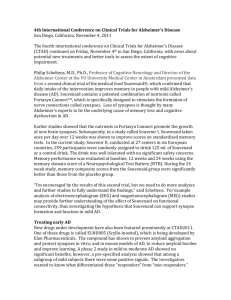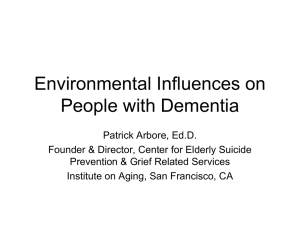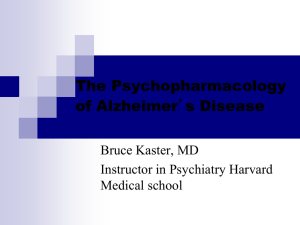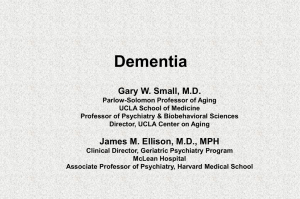The Head, Hands, Heart Dementia Assessment
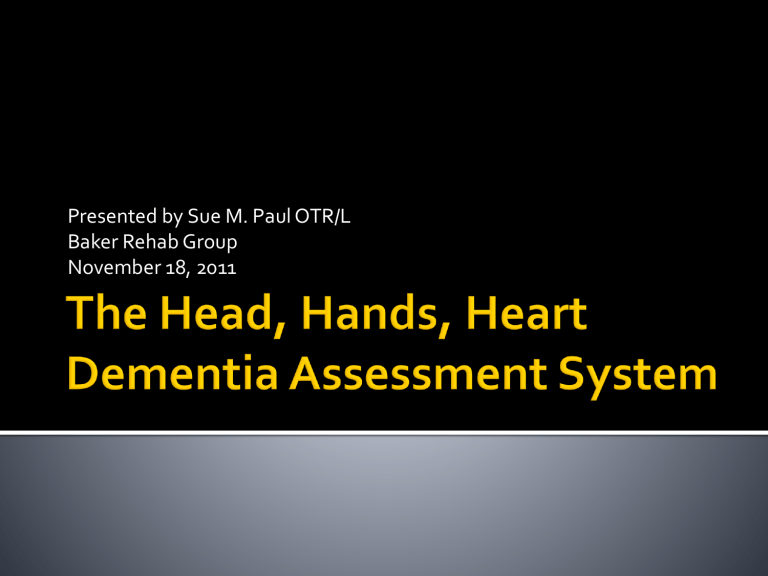
Presented by Sue M. Paul OTR/L
Baker Rehab Group
November 18, 2011
Understand memory and sensory processing in the demented brain.
Identify the hallmark characteristics of each stage of dementia.
Identify skills and deficits that could benefit from therapy services.
Understand the assessments available to determine a level of dementia.
Identify best practices and interventions for developing treatment plans and goals.
Alzheimer’s disease
Parkinson’s disease (20%)
Vascular (Multi-infarct)
Lewy Body (fluctuations and hallucinations)
Creutzfeld-Jakob (Mad Cow)
Pick’s disease (Frontotemporal)
Korsakoff’s Syndrome (ETOH)
http://www.alz.org/documents_custom/2011
_Facts_Figures_Fact_Sheet.pdf
Only taught “traditional learning” in school
Old days, insurance wouldn’t pay if dementia was a diagnosis
Compensation not viewed as rehabilitation
Learn neuromuscular strategies for brain injury, CVA, and pediatrics, but not specific to
Alzheimer’s brain.
Access the Alzheimer’s brain through nontraditional approaches
Pull from neuro and pediatric techniques used in other settings
Rehabilitate, then compensate (yes you can do both)
Focus on someone with a non-Alzheimer’s brain to carry out interventions
Language comprehension
Short term memory
Long term memory
Explicit memory- new learning
Executive function
Multitasking
Judgment
Abstract thinking
Mental flexibility
Problem solving
Attention
Initiation
Inhibition
Language production
Persistence
Volition
Visual recognition
People
Things
Sensory Cortex
Motor Cortex
Some attention and language
Automatic motor tasks
(ADLs)
Motor control/smooth movements
Balance/gait
Sustained attention/effort
(brainstem)
Mental speed
Posture
Critical for laying down declarative memory
Must have bilateral damage to hippocampi to affect memory (not usually memory loss from cva)
Very susceptible to Alzheimer’s disease and epilepsy
Just in front of the hippocampus
Perceives fear, and initiates fight or flight
“Un-erasable” memory (PTSD)
Some people are genetically wired for higher level of fear (panic disorder)
Amygdala is bigger in people with bipolar disorder
“Conditioned” fear response- stuck in a fear circuit
Working memory- most short term, repeats directions or adding numbers in head, forgotten as soon as attention stops
Declarative memory- long term memory, laying down new memory, hippocampus dependent
Procedural memory- most durable, actions, habits, and skills that are learned by repetition, cerebellum involved
Also known as
Implicit Memory
Learning without awareness
Motor Memory
* Does not pass through hippocampus*
Task specific
Use automatic patterns (feeding, translation)
Repetition breeds performance
No generalizing
Amnesia
Aphasia
Apraxia
Agnosia
Activity #1
Routine Task Inventory
Global Deterioration Scale/ FAST
MMSE
Clock Test
Placemat
*Flip Book*
“ Retrogenesis is the process by which degenerative mechanisms reverse the order of acquisition in normal development.”
BACK TO BIRTH
Developed by Dr. Barry Reisberg
Basis of Functional Assessment Staging Test
(FAST)
Basis of Global Deterioration Scale (GDS)
“Functional cognition encompasses the complex and dynamic interactions between an individual’s cognitive abilities and the activity context that produces observable performance.”
Developed by Claudia Allen, OTR/L
Originally called the Cognitive Disabilities
Theory, Allen described observations categorized by the functioning of psychiatric patients.
Basis of Routine Task Inventory, Allen
Cognitive Level Screen, and the placemat activity
See handout
Administered as supportive assessment of suspected dementia level.
Not a standardized test
Good, subjective tool for sizing up organizational skills, visual processing, and personality changes
“Make yours look like mine”
MMSE
Developed by Marshall Folstein in 1975
Score 25/30 considered normal
Early stage Alzheimer’s usually falls between
19 and 24.
Disadvantages- need to account for age, education, and ethnicity
Physicians love it
Flip book
Data collection
Website
Procedure for printing
http://headhandsheart.com/login.asp
Allen Level 4
GDS 4
MMSE <25
Developmental Age 4-12
*Goal Directed*
Rigid, inflexible thinking
Egocentric
Independent familiar ADLs
Denies impairment, defensive
Depression, anxiety, fear, anger
Needs assistance with finances, appointments, medications, home management
Well, maybe you say it’s wrong but that’s just the way I like it.
My way is the best way.
Cognitive skills/Communication:
Understands beginning, middle, and end of an activity.
Can seek help but may not remember emergency procedures.
Rigid, likes routine.
Self-centered communication, confabulates, high verbal output.
Recognizes highly visible striking cues in the environment.
Limited reading comprehension.
New learning possible with maximum repetition if highly valued.
Believe that nothing is wrong with them.
Copyright © 2003
Precautions:
Unable to understand precautions, complications,
hazards.
Written language is not reliable.
Signs are not really effective.
Copyright © 2003
If you tell me to go brush my teeth I will stay on task.
I just may forget to use toothpaste or rinse out my mouth.
Feeding:
May eat too fast or too
slow.
Annoyed with others
eating near them.
Complains about food.
Grooming:
May neglect unseen
surfaces (back of head).
Sequencing errors.
Copyright © 2003
I am really drawn to bold, striking visual input.
Did you ever notice that I choose bright clothing and wear too much makeup?
Dressing/Bathing:
Performs familiar self care with decreased attention to unseen surfaces.
Follows routine.
Remembers what they are doing throughout task.
Clothing selection may be based on striking features
(brightest shirt in the closet).
Quality may not be good.
Copyright © 2003
This is a huge loss of dignity for meand a very overwhelming task at times.
Toileting:
May neglect parts of
the task.
May require verbal
reminders to initiate task.
Completes the task although quality may not be good.
Copyright © 2003
I can remember new things with tons of patience and practice!
Functional Mobility:
Able to navigate using
familiar landmarks.
Transfer skills depend on
familiarity of environment.
Carries walker if distracted, but will correct with cues.
Notices barriers above and below knee.
Trunk becoming more rigid.
Decreased trunk rotation
Weak core
Stooped posture- looking to floor for stability
Shoulder internal rotation and adduction
Cannot sustain verbal commands
Cognitive remediation
Compensation
Adaptation and Modification
Balance
Body awareness
Core strengthening
Facilitate the tough conversations
Driving
Additional care
Living arrangements
Organize environment
Put strategies in place
Use motor learning/repetition to bypass hippocampus
Introduce adaptive equipment now
Cognitive remediation to the fullest extent possible- evaluate reading and memory.
If they do it, they will remember it (marking calendar, schedule...)
Don’t ask for permission or approval. Use positive, affirming conversation- use “we” not
“you”.
Use activities with hidden agenda
Constantly evaluate motor skills and weaknesses
Practice concepts like in/out, sorting, categorizing- and generalizing skills to other tasks
Stop talking!
Allow extra time to process verbal commands
Use gestures/demonstration frequently
Always sequence left to right
Scavenger hunts:
Above/below knee level
Above/below eye level
Activity #2
Dementia Level
Goals
Treatment Plan
Caregiver Instruction
What skills do you want to maintain?
What information is most useful to caregivers?
What are your recommendations for functional maintenance program (ISP?)
How much assistance/supervision is necessary?
Repeats herself
Denies deficits
Walks with a cane, looks at floor
Can put on clothes, but doesn’t take season or occasion into account
Can print name but not write signature
Husband talks her through ADLs, complains that she is distracted and it takes a long time
Anxious about showering, trembles. Exiting stall shower is very unsafe and upsetting
Toilets herself but uses too much toilet paper
Sundowns- wants to go home to mama and daddy
Doris
• Repeats self throughout activity
• Needs encouragement to
• continue
“This is dumb.”
• “I’ve done this before.”
•
• “I’m no good at handiwork.”
I need my glasses.
Allen Level 3.0- 3.8
GDS 5
Developmental Age 1.5-3 years old
*Decreased sense of task completion*
You may notice that I play with my food or grab other’s food from their plates. I’m easily distracted and overstimulated.
Feeding:
May reach for food from other place settings or centerpiece
Unable to complete meal without redirection and set-up
Plays with food and utensils
Copyright © 2002
I am sometimes very resistant to care. Don’t you sneak up on me or just might get slugged!
Self-care skills:
May initiate action with familiar object- but not sustain to completion
Resistant to care
Layers clothes until all items used up, unable to orient clothing or sequence task
Needs supervision or assistance with toileting
Copyright © 2002
I hate confinement and may try to get out! I want to walk walk walk!
Functional Mobility:
Limited head/neck/trunk movement during walking
Does not scan environment
Has trouble stopping, may trip
May be impulsive
Frequent fallers
Copyright © 2002
I have to get out of here. I’m late for work and the train is on that other thing over the @#%*! out that window day
@#%*! right here in
Chantilly .
Cognitive skills/ communication:
Able to name objects
Decreased sense of task completion
Needs verbal cues to sequence steps of an activity
Responds best to demonstrated instructions
Word finding problems
Loses the thread of a story
Jargons, incoherent sentences
Copyright © 2002
I love to use my hands...and touch everything! I tend to get into things I shouldn’t and carry them around with me.
Precautions:
At risk for falls
Unable to understand precautions, complications, or hazards
Does not recognize need for help
At risk for accidentspoison, sharp objects, elopement
Copyright © 2002
Have you seen my mother?
Has anyone seen my mother ?
Behaviors:
Pacing, repetitive actions
Agitated, worried, trembling hands
Unpredictable with social interactions
Confused, acts randomly
Copyright © 2002
I have to get out of here. I’m late for work and the train is on that other thing over the @#%*! out that window day
@#%*! right here in
Chantilly .
Cognitive skills/ communication:
Able to name objects
Decreased sense of task completion
Needs verbal cues to sequence steps of an activity
Responds best to demonstrated instructions
Word finding problems
Loses the thread of a story
Jargons, incoherent sentences
Copyright © 2002
I am sometimes very resistant to care. Don’t you sneak up on me or just might get slugged!
Self-care skills:
May initiate action with familiar object- but not sustain to completion
Resistant to care
Layers clothes until all items used up, unable to orient clothing or sequence task
Needs supervision or assistance with toileting
Copyright © 2002
I hate confinement and may try to get out! I want to walk walk walk!
Functional Mobility:
Limited head/neck/trunk movement during walking
Does not scan environment
Has trouble stopping, may trip
May be impulsive
Frequent fallers
Copyright © 2002
Implicit/Procedural
Motor Learning!
Specific transfers
Gait training with demonstration
Post-It Notes
Count the pictures
Reciprocal, gross motor movements
Neuromuscular Re-education
AROM
Core strengthening
Cognitive compensation
ADL focus on highly familiar tasks
Balance training/fall prevention
Enabling devices
Bed handles
Grab bars
Rollator if familiar
Balloon batting
Ue rom
Open hand
Automatic response
Sitting or standing
Balance training
Alternate/reciprocal
Postural adjustments
Post-It Notes
Place at different heights around room
PNF patterns/ rotation
Above/below knee level and eye level
Search inside cabinets and drawers
Activity #3
Ed
•
•
• Pretty steady attention span
Breezes through it
Cannot follow pattern or remember to refer to it.
Moved into ALF 3 years ago with wife. She died shortly after. Retired optometrist.
Was very high functioning but depressed for several months. Quick decline in mental status after suffering a fall and hip fracture.
Moved to memory care unit six months ago.
Will not participate in activities.
Will not sit through entire meal.
Very sweet and pleasant.
Staff has him labeled as sexually inappropriate because he tries to touch them all the time.
Loses the thread of a story, poor word finding
Anxious and wandering at times, socially withdrawn other times.
Helps with putting shirt on but is easily distracted and stops what he’s doing.
Walks down hall holding onto railing and furniture. Multiple falls.
Dementia Level
Goals
Treatment Plan
Caregiver Instruction
What skills do you want to maintain?
What information is most useful to caregivers?
What are your recommendations for functional maintenance program (ISP?)
How much assistance/supervision is necessary?
Tap into long term memory for functional use of hands
Haptics
It’s all about the hands!
RELEASE!
Instinctual play
Doll
Dog
Allen Cognitive Level < 2.8
GDS 6 and 7
Developmental age infant to
1.5 years
* Unable to Release*
Allen Level 1:
Mostly bedbound
Can move limbs and
head
Total assistance for self care and mobility.
Developmental age infant
Allen Level 2:
Can overcome gravity
Can sit, stand and/or
walk (mobility)
Have a sense of balance, although not good
Developmental age 1-2
Copyright © 2002
Because I can’t move or communicate well, I’m really at risk for contractures, falls, and skin breakdown. YOU can prevent this from happening to me!
Precautions:
Contractures
Skin Breakdown
Falls
Aspiration
Copyright © 2002
A funny trick I know:
I may only be able to say one or two words, but I can sing a whole song without any errors.
Cognitive Skills/
Communication:
Speech mostly unintelligible, mumbles incoherently
Unable to follow most verbal commands
Poor attention span, distracted by moving objects
Copyright © 2002
I can only see things less than
12 inches from my face.
Bring the world to me!
Feeding:
May be able to feed
self with limited or extensive assistance
More successful with
finger foods
Can sip from a cup held to lips until very end stages- don’t introduce a straw too early!
Copyright © 2002
I have a major fear of falling. I may resist, hit, or kick but it’s only to protect myself from injury. I’m not just being difficult.
Dressing/Bathing/
Grooming:
Has no idea what to do with objects
Assists caregivers by holding positions, moving limbs, and standing
Copyright © 2002
You may know me by my
“death grip”. I have a hard time releasing things from my hands.
Toileting:
Needs assistance with managing clothing, perineal hygiene, and positioning on toilet
Frequently incontinent
Inappropriate toileting locations- sometimes the same place over and over.
Can assist caregiver by holding onto grab bar.
Copyright © 2002
I can turn my head to track a moving object even at the last stages of my disease.
Give me moving stuff to look at!
Functional Mobility:
Higher level “hearts” walk aimlessly, pace, rock, and march.
Lower level “hearts” can only respond with a
grimace or glance.
Seek stability and comfort
Enjoy gross motor activities- without a sense of purpose .
Copyright © 2002
Lift someone under the arms, legs will flex
Have person pull up at bar, legs will extend to bear weight.
Sucking reflex
Rooting reflex
Palmar grasp reflex
Babinski reflex
*The areas of the brain that are last to be myelinated during development are the most vulnerable to death*
Seating and Positioning
Functional use of hands
Interaction with environment
Caregiver training for quality of life issues
Aspiration
Skin breakdown
Comfort/pain
Contractures
Touching
ADLs for object recognition
How do they hold it in their hand?
Pull to stand
Self feeding
Visual tracking, turning head, reaching for items
Use reflexes to elicit movement- rooting, protective extension, hand-to-mouth movement patterns.
Activity #3
Nonverbal
Bilateral UE/LE contractures
Rigidity
Death grip
Falls forward out of chair
Inconsistently uses fork appropriately, puts everything in mouth
Does not consistently bear weight for transfers
Find the exit signs
Count the pictures on the wall
Pull off the post its
Balloon batting
Completed by OT online near end of episode
Copy is sent to physician and family
Copy placed in ALF chart if applicable
Used as a tool to educate caregivers and give objective recommendations based on dementia findings
Make it smart!
What is the purpose of your intervention?
▪ To improve..
▪ Trunk and pelvic stability?
▪ Functional reach on a stable base?
▪ Sequencing and task organization?
▪ Postural deformities?
▪ Risk of falls?
▪ Risk of contractures?
▪ Risk of skin breakdown?
▪ Socialization and interaction with environment?
Who cares how you get there!
“Upright and midline posture necessary for:”
Improved air exchange
Improved socialization
Preventing abnormal postures
Promoting functional use of upper extremities
Improved communication
Decreased caregiver burden
Preventing falls and decreased skin integrity
Balloon
Pen, screwdriver, paintbrush, toothbrush, flashlight
Lipstick, mascara, nail file, nail polish, brush
Post-it Notes
Painter’s tape
Start with what you know
Don’t listen, watch.
What does this disease looks like at the end?
What are the associated complications of
Alzheimer’s?
What can you do to put off the inevitable?
What works? What doesn’t work?
Determine the level of dementia
Visualize one level down the road
Use the backdoor to the brain
Implicit/motor memory
Demonstration
Repetition and consistency
Alzheimer’s research- prevention
Estrogen
Insulin
Antioxidants
Anti-inflammatory
Genetics
Alzheimer’s research- therapies
Aricept stops breakdown of acetylcholine
Namenda works by binding to the NMDA receptor and preventing excessive excitation by glutamate.
http://www.wiredtowinthemovie.com/mindtrip
_xml.html
http://www.bakerrehabgroup.com/assets/cms/f iles/Articles/Retrogenisis%20Theory.PDF
http://www.bakerrehabgroup.com/assets/cms/f iles/Articles/Alz%20Disease%20and%20Implici t%20Memory.PDF
http://www.bakerrehabgroup.com/assets/cms/f iles/Articles/Routine%20Task%20Inventory%20
Expanded0023.PDF
http://www.bakerrehabgroup.com/assets/c ms/files/Articles/Assess%20Approach%20of
%20Pt%20w%20dementia.PDF
http://www.bakerrehabgroup.com/assets/c ms/files/Articles/Primitive%20Reflexes%20i n%20AD%20.PDF
http://thedementiaqueen.com/about/
Sue M. Paul OTR/L
Chief Operating Officer
Baker Rehab Group http://www.bakerrehabgroup.com
